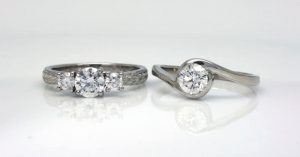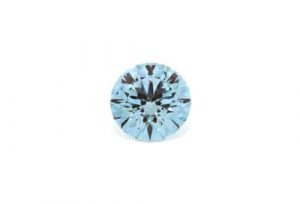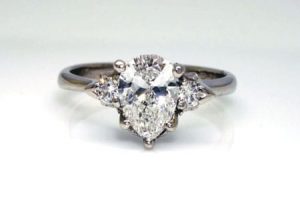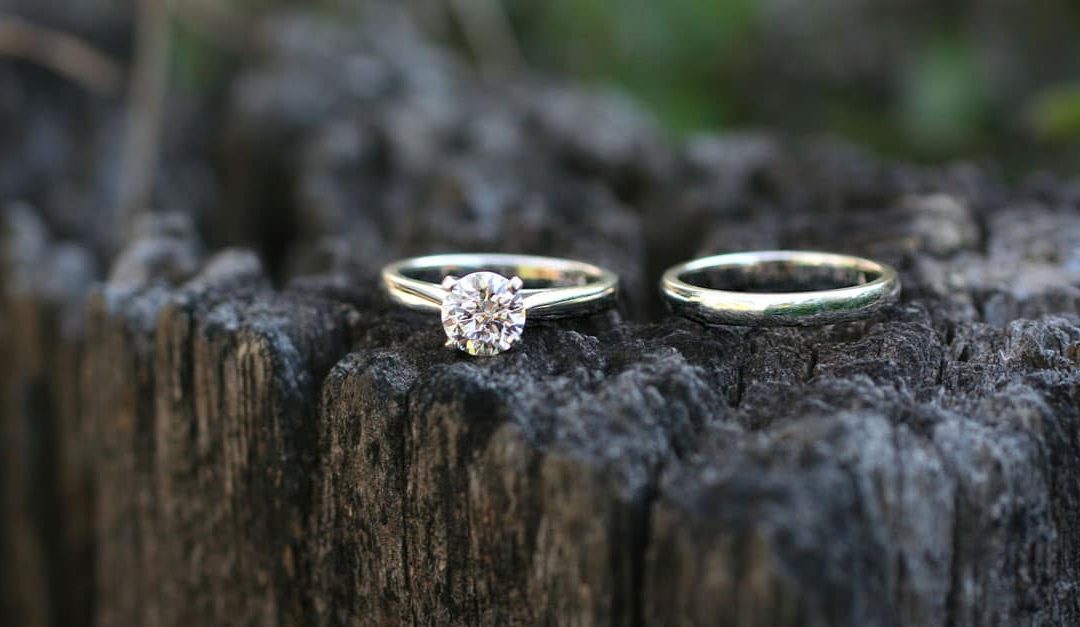The marketing ‘war’ going on right now between mine-origin and lab-grown diamonds is fascinating to watch and a lesson for anyone wanting to break into a well-established, old school marketplace – or defend it.
If I didn’t know better, it’d be easy for me to think the whole discussion around lab-grown diamonds vs mine-origin diamonds has developed its own gravitational field.
Just when I’m about to broach a different aspect of the jewellery industry, something pops up to suck me back in to the argy-bargy going on between the two camps.
And make no mistake, it is argy-bargy (a noisy quarrel between participants in an argument).
Why do I care?

The ring on the left features lab-grown diamonds. The one on the right, an Argyle mine-origin diamond. Consumers can’t tell the difference just by looking at them, so how else do you set them apart?
First, let me make it clear I don’t have a foot in either camp.
And, to a large extent, I really don’t want there to be a winner and loser. My preference is for both to win. There doesn’t have to be a loser.
So, what do I care about?
What I care about is whether our customers are getting good information so they can make rational decisions about which is right for them.
I’ve said it before, and I’ll say it again. Ethics is a personal thing.
In the context of lab-grown and mine-origin, some people have a problem with mining and some people dislike the idea of human-made. Either way, neither group can make good decisions with bad information.
What set me off this time?
Two things really.
One was an article on benzinga.com shared on LinkedIn titled “5 Earth Day Reasons to Choose Lab-Grown Diamonds”.
The other was preparation work for an interview with an industry publisher that lead me to revisit a bunch of the negative issues associated with diamond mining.
You see, before I became involved in the jewellery industry about 12 years ago, I used to be a management consultant specialising in sales and marketing.
I lived and breathed marketing for the best part of 17 years – particularly for small and medium business. At least one thing experience like that gives you is the ability to see straight through lazy and surreptitious promotional material.
As a hitherto marketing professional, it’s disappointing but not surprising.
As a consumer advocate, it’s downright aggravating and frustrating.
It’s aggravating because of the obvious half-truths and the contortions of the facts. And it’s frustrating because of all the missed opportunities to do the job soooo much better.
In relation to the benzinga article, basically it was a press release a for Spence Diamonds (a jewellery company originating in Vancouver) that recently started selling laboratory-grown diamonds alongside their mine-origin diamond offerings .
Here it’s important that I stress I don’t have anything against Spence Diamonds. In many respects I’m inclined to say good on them for reading the market and being prepared to venture away from the mine-origin dogma plaguing that sector of the jewellery industry.
But what I do take issue with is the light-weight way in which laboratory-grown diamonds are sold as a more ethical alternative than mine-origin diamonds. As it happens, the Spence Diamonds PR piece is a perfect example of just how shallow the pitch is.
What are my problems with Lab-grown diamond marketing?

This stunning 1.43 carat lab-grown blue diamond is vastly more affordable than anything like it that might’ve come out of the ground. It’s no wonder lab-grown is getting so much traction in the market.
This criticism by no means applies to all lab-grown diamond producers, but let’s tell it like it is.
Lab-grown diamond producers have been very backward in coming forward with specific details about one of their key selling points – their supposed very low carbon footprint (relative to mine-origin diamonds).
Almost the entire sector has claimed this as a selling proposition without substantiating their own track record in this regard.
Collectively they’re basking in the glow of a few high-performers, consistently using vague terms like ‘eco-friendly’ to promote themselves. Many are scoring undeserved points with consumers as a result.
The reality now appears to be that lab-grown diamonds could easily have the same, or an even worse carbon footprint than mine-origin, depending on where the energy used to grow them comes from.
Likewise, there’s rarely any mention about the diamond cutting and polishing side of things, nor conditions for the jewellery manufacturers.
These latter issues are ignored most likely because they’re below most consumer’s radar.
And when it comes to condemning the mining industry, sweepingly vague claims are made about things like workplace health and safety and conflict funding when industry insiders know these issues only really apply to a small percentage of diamonds in circulation.
Mind you, none of this is to say the mining industry doesn’t deserve criticism. It does.
The mine-origin industry needs to lift its game

This trio of Argyle mine-origin diamonds, apart from being beautiful, have a very positive back-story to support them. Why not tell it?
There’s not denying the diamond mining industry has a crappy history. At times a very crappy history. But my intent here is not to take issue with diamond mining (though I do have my fair share of concerns).
My issue for today is that the mine-origin industry and the jewellers and retailers who support them are doing a lousy job of marketing their product in the face of lab-grown competition.
Lab-grown producers are running circles around them.
There’s a new, younger bull in the paddock
Here’s the thing, the mine-origin industry has been the only bull in the paddock for the best part of 100 years now – ever since diamonds became an aspirational ‘must have’ in the ‘30s.
The mine-origin bull has had the farm all to itself. It has grown fat and lazy, trotting out the same old pick-up lines to woo the herd. (A herd that really didn’t have much of a choice anyway.)
Now there’s a new bull in the paddock.
It’s younger, more agile, has a few tricks up its sleeve and isn’t too worried about playing fair.
A portion of the herd is quite interested in this new bull. It seems to have a lot going for it. But the best the old bull can do is trot out the same old chat up lines while trying clumsily to push the new bull back out of the paddock (pleading to farmer Federal Trade Commission for help).
Now, if that sounds harsh, that may be so. But you can’t tell me it’s not true.
To date the mine-origin diamond industry and their retailers have failed miserably in their efforts to address the ‘marketeering’ of the lab-grown sector. That’s all there is to it.
Specifically, what are mine-origin marketers doing wrong?
Well, there’s few things …
- Doing nothing isn’t a solution. Many jewellers and retailers are carrying on regardless, heads stuck in the sand, hoping the big, bad lab-grown people will go away. Newsflash. They’re here to stay;
- Pretty pictures are not enough. Images of diamond jewellery help to sell jewellery, but they don’t help to differentiate mine-origin from lab-grown;
- Praising the dazzling virtues of (for most people) unobtainable, ridiculously large stones (fancy or otherwise), might grab the serious interest of the very wealthy few, but again, it doesn’t differentiate mine-origin. It may, in fact, drive the average consumer to seek out more affordable lab-grown alternatives so they can have a ‘big is better’ stone too;
- Trite tag lines like “Real is rare” aren’t helping. After all, is real really all that rare? And even if it is, so what? How does that help me, the consumer? It certainly doesn’t play out in terms of resale value;
- “Mine-origin diamonds can achieve record prices.” Again, so what? It’s a meaningless statement for the vast majority of consumers, and it is no indicator of future investment or resale value;
- “Lab-grown diamonds are mass produced.” … So what? Another easily countered claim. They’re not produced in anything like the quantities mine-origin diamonds are, and unlike the Diavik Diamond mine, you can’t see any of their factories from space; and
- Arguing about nomenclature … lab-grown/lab-created/synthetic or whatever …
For Pete’s sake, let it go. The FTC have made their call and they’re enforcing it (in the US anyway). It’s time to move on and focus on what consumers really care about. The whining about the legitimacy of -grown/-created/synthetic just sounds like a whole lot of sour grapes. The gate is open and the horse has bolted. Deal with it.
What could mine-origin do instead?
Traceability, as a marketing initiative, is a step in the right direction. But like the lab-grown industry’s wanton and often unverifiable claim of an ‘ultra-low carbon footprint’, it could easily become an Achilles Heel.
Don’t get me wrong, I support traceability, but I also understand the positive implications and where the loop holes are. Most consumers don’t.
It’s also true that the traceability only applies to a handful of producers and resellers. Spruiking it too early could severely damage the wider industry and play right into the hands of the lab-grown sector. Especially as there are still huge inventories of untraceable diamonds in the system yet to be sold.
Transparency and responsibility at the retail level

Our own research amongst ethically-minded jewellery consumers is suggesting they care more about people than they do carbon cost.
Ultimately, it’s at the retail level where the rubber hits the road.
Customer-facing retailers and manufacturers are the interface with the market. And the market cares more now than ever before about things like ethics, sustainability, human rights, environmental issues and climate change.
The lab-grown sector is doing a reasonable job of appealing to these wants of the burgeoning Millennial and Gen Y markets. Mine-origin however, has a lot of catching up to do.
Now, it might seem like Lab-grown is holding all the marketing cards in this game, but they’re not.
I happen to think that a great many people still really like mine-origin diamonds. The Industry just has to give them more compelling reasons not to stray over to the new bull in the paddock.
Retailers need to tell a (truthful) story consumers care about …
- Where do their diamonds come from?
- What’s their carbon footprint and how does it stack up?
- Why did they choose that supplier?
- What is that supplier doing to invest in and support mining communities?
- What does the mining company do to protect local environments and rehabilitate mine sites?
- Where are the diamonds cut and how well are the cutters and polishers treated?
Answering those questions in their promotional efforts would go a long way towards winning back wandering herd members.
Add to that relevant and meaningful ‘corporate responsibility’ actions – like off-setting carbon emissions and supporting artisanal mining communities – will help with positively influencing consumers.
Back to the elephant in the room
Most of you I’m sure will have picked up on my blatant (and click-baity) corruption of the Not-all-men hashtag in the headline of this article.
I mean no disrespect to the #metoo and #notallmen movements. They’re critically important elements in much needed social change. I’ve borrowed the concept because the not-all-men message perfectly exemplifies where the diamond industry is at right now. At least in my opinion.
Just as not all men are guilty of misogynistic behaviour, not all mine-origin diamonds are compromised by the claims made by the lab-grown sector. Likewise, not all lab-grown diamonds are as squeaky clean as we’re being led to believe.
The difference here is that most people have enough life experience to know intuitively that not all men deserve condemnation. The same cannot be said about people’s experience with diamonds however. The majority of consumers don’t know what they don’t know and are open to suggestion.
The fact is, whomever is better at communicating their slant on the diamond story will gain or retain their fair, or unfair share of the herd.
Either way, there’s a big upside
As I highlighted early in this article, I’m not picking sides.
The reality is mine-origin isn’t going anywhere anytime soon, and lab-grown are having too much success to do anything other than continue full steam ahead.
What appeals to me is this vigorous ‘conflict’ is forcing both sides to lift their game. To be more transparent and become more socially and environmentally responsible.
That’s a really good thing, and we shouldn’t underestimate how important it is.
In short: Hooray for competition!
About EJA
Ethical Jewellery Australia is an online engagement, wedding ring specialist and bespoke jewellery specialist. Every piece we do is custom designed and made to order (with the exception of simple wedding and commitment rings that are offered in a range of simple, popular designs).
We take our customers through the whole process from design to sourcing and finally to manufacturing.
All rings are handmade in Australia with recycled metals. (We can also supply Fair Trade gold if requested.)
Likewise, we only every use ethically sourced diamonds and gemstones. You can choose from Argyle, recycled, vintage and lab-grown diamonds, Australian, US, Fair Trade, recycled and lab-grown coloured gemstones.
By the way, we offer an Australia-wide service.
About the Author: Benn Harvey-Walker
Benn is a Co-founder of Ethical Jewellery Australia and a keen student of ethical and sustainability issues in the jewellery world. He has a long history in sales and marketing and began working with EJA full time in early 2018.
Benn co-authored the original Engagement Ring Design Guide in 2014 and edited the 2nd Edition in 2018. He is also the principal author of our Wedding and Commitment Ring Design Guide.
His main responsibilities at EJA are business development and sales process management. Benn also creates technical drawings for our ring designs.


Recent Comments